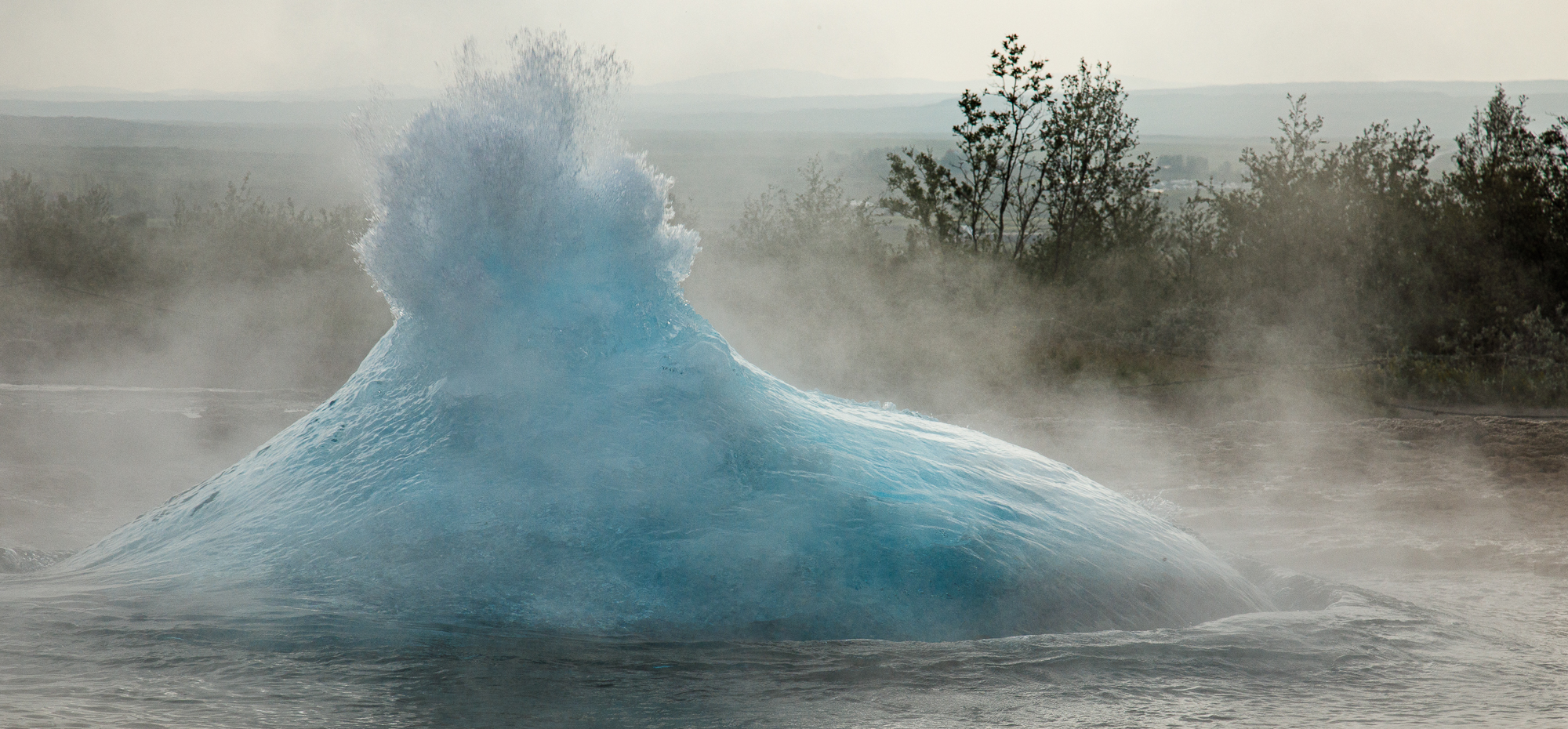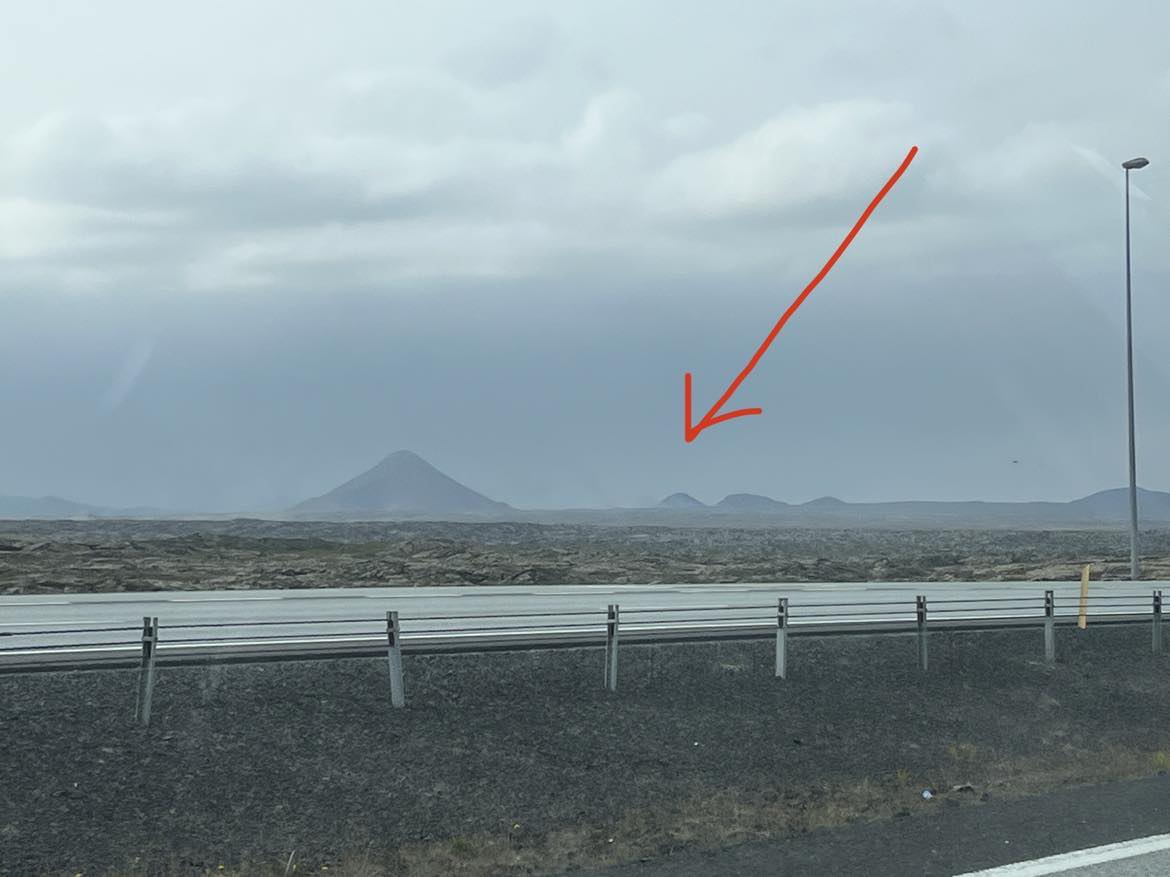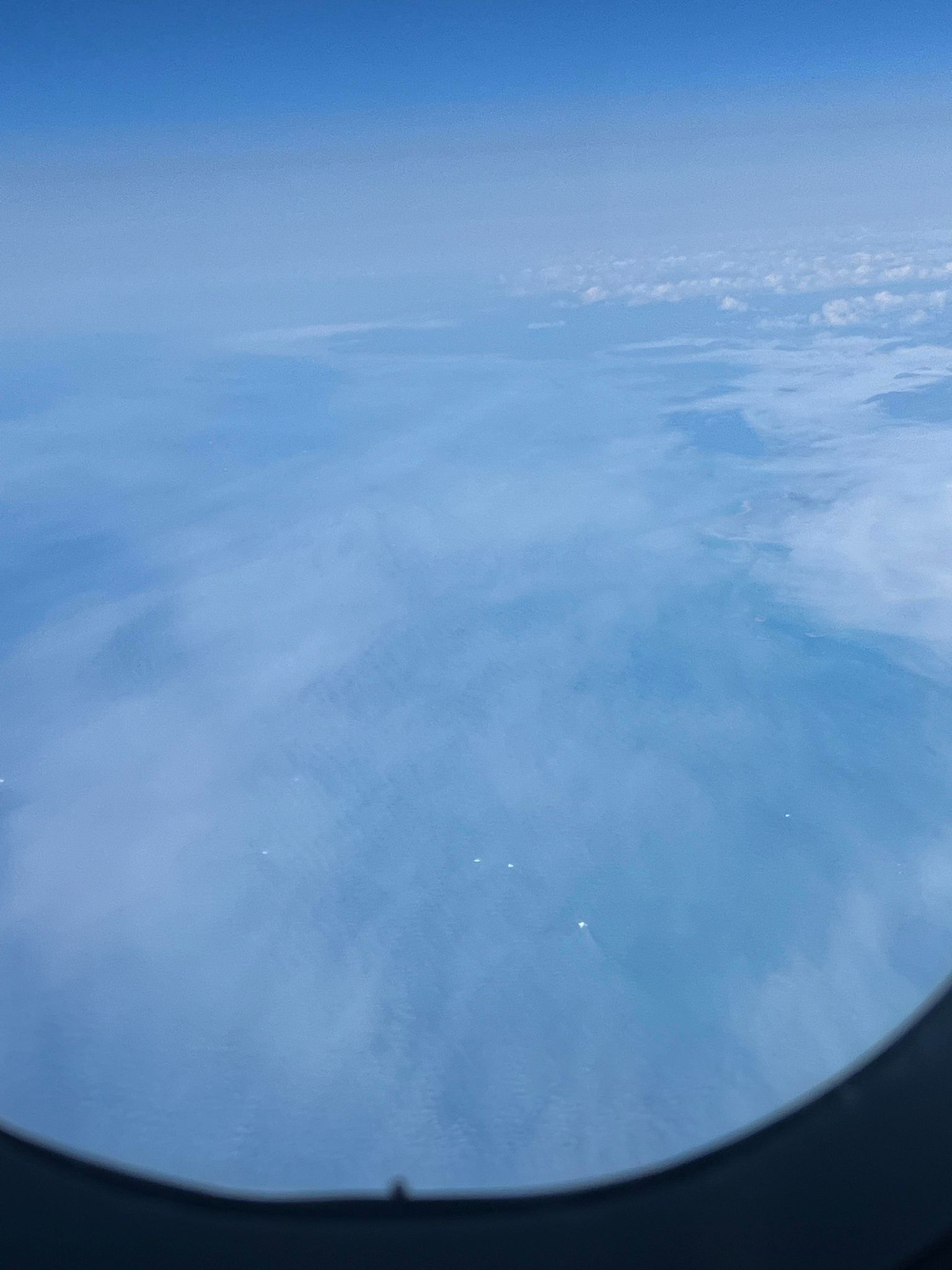I sat on the ground and ran my hands through dirt that was both novel and familiar.
The Haukadalur thermal area was a new location for me, but the sensations that occupied
it were intimate. Volcanically driven hydrothermal areas smell like sulfur and the air is
saturated with steam. The ground is damp and the soil is thin and filled with gravelly sinter.
Water emanates from all over the place: seeping quietly from the soil, trickling away from springs,
and exploding into the sky from geysers. It is, for most people, a startling environment and tourists
flock from around the world to see places like this.
For myself it is a home, one where I feel comfortable and connected to the Earth.
The Haukadalur thermal area provided a grounding after spending the last twelve hours hiking through
an active volcanic field and watching a volcanic eruption: a decidedly unfamiliar place for me.
It had been three years since I last sat in a thermal field, three years in which I wasn’t sure if
I’d ever return to one. The enveloping steam from erupting geysers hugged my soul in a way few things can,
and I realized it was an old friend who would never leave.
We left the parking area for the volcano four hours earlier and made our way north from the Reykjanes peninsula and
into the Icelandic interior. I was impressed by the scenery along the way. Our route took us along the southern
Icelandic coast for a few miles before turning north towards Selfoss and through rolling fields. We stopped for
food in Selfoss. Hope found something to eat, but I was happy with the Mountain House I brought so I settled for a
half-bottle of a dry red wine to go along with it.
An hour later we rolled into Haukadalur. This area is best known as the location of Geysir the eponymous
thermal feature that gave its name to the several hundred others across the globe. We grabbed a campsite at
Camp Geysir and made dinner. I threw my mountain house into a cup and poured the bottle of wine into a travel
mug and ate my dinner in front of Strokkur – the most frequently erupting feature in the area.
Chasing the Fire, Part 5 - Coming Home
Everything else seems kind of boring?
Published on Wednesday, 17 October 2023. Revision 0.

Chasing the Fire, Part 5 - Coming Home
Everything else seems kind of boring now.
Published on Wednesday, 18 October 2023. Revision 0.
Blue Bubbles
As far as geysers go, Strokkur is a bit of an anomaly. It’s eruptions are large, powerful, and frequent.
It’s eruptions occur every 2 to 15 minutes and almost inevitably begin with an explosive burst of water
being sent upwards of 50ft into the air. These bursts of water frequently begin within a “blue bubble”
– a doming of the surface of the pool of quiet water with steam bubbles forcing themselves upwards. '
These blue bubbles are noted for their quiet, rapid, and smooth rising followed by a loud and violent
pop as the steam breaks the surface tension and explodes into the atmosphere. For most geysers, blue
bubbles are either rare or poorly defined. Strokkur makes one almost every time it erupts. For a geyser
enthusiast it’s a visual spectacle unmatched anywhere else.
Strokkur is also a moderately complex feature. An underreported feature of its eruptions is that the interval of time between eruptions is dependent on the nature of the first eruption. Strokkur erupts in a series of distinct bursts of water – anywhere from one to five. The number of bursts in an eruption determines the amount of time before the next eruption. Size of the bursts doesn’t seem to matter – just the number. An eruption with one burst of water may be followed by another eruption only a couple of minutes later while an eruption with several bursts may require up to twenty minutes to recycle.
In 2020, study of 73,466 of eruptions remotely monitored by seismic sensors and found a strong correlation between the number of bursts and intervals. Their report can be read here. Their results speak for themselves.
Of course, I didn’t spend much time thinking about the dynamics of Strokkur’s behavior. Mostly I just sat in the cool and damp evening air and allowed myself to relax and bask in the glow that accompanies a clear cut personal victory such as this trip had been.
We had done it. The odds were not really in our favor. We had to wait for a volcanic eruption within our financial and logistical constraints, then to mobilize ourselves to get out to the location, then to hope that the weather, authorities, and volcano cooperated. That required a lot of things out of our control to go correctly and demanded that we be able to pivot and adjust our plans within a highly dynamic situation.
That it worked was nothing short of a miracle. The reality that it worked would wash over us as waves of uncontainable joy and glee. We would break out in giggles and smiles, and sometimes tears. We had done it, damn it, we had really done it!
We finally slept for the first time in just over 48 hours. I think I managed about three and a half hours of very shallow sleep.
In 2020, study of 73,466 of eruptions remotely monitored by seismic sensors and found a strong correlation between the number of bursts and intervals. Their report can be read here. Their results speak for themselves.
Of course, I didn’t spend much time thinking about the dynamics of Strokkur’s behavior. Mostly I just sat in the cool and damp evening air and allowed myself to relax and bask in the glow that accompanies a clear cut personal victory such as this trip had been.
We had done it. The odds were not really in our favor. We had to wait for a volcanic eruption within our financial and logistical constraints, then to mobilize ourselves to get out to the location, then to hope that the weather, authorities, and volcano cooperated. That required a lot of things out of our control to go correctly and demanded that we be able to pivot and adjust our plans within a highly dynamic situation.
That it worked was nothing short of a miracle. The reality that it worked would wash over us as waves of uncontainable joy and glee. We would break out in giggles and smiles, and sometimes tears. We had done it, damn it, we had really done it!
We finally slept for the first time in just over 48 hours. I think I managed about three and a half hours of very shallow sleep.
Lost Keys
With morning came an open camp office and a glorious shower powered by the naturally hot groundwater of Iceland. I made a cup of coffee and took it in the shower with me. Then I moseyed back out to the geyser fields to see and photograph a few more eruptions of Strokkur. The early morning sun was poking through the clouds occasionally and bringing warm dramatic light to the eruptions.
Another feature was erupting while I was there – a feature close to the paved trail between Litli Geysir and Smidur. It was erupting every few minutes with eruptions that were clearly either major or minor eruptions. Major eruptions were every twenty minutes or so and had nice bursting up to 6 feet tall. Minor eruptions were more frequent and significantly smaller. The existing map at the kiosk didn’t label this feature and it was not until I got home that another geyser gazer, Graham Meech, provided a name for the feature: Alfaagua Geysir It was a nice touch to the trip.
We packed up the car to leave for the airport and when I tried to start the car the vehicle’s dash displayed a message: “Bring key fob closer to the steering wheel.” Confused, I looked for the fob in my pocket where it had been but it was gone. I searched around the front seat and came up empty. Within ten minutes we were ripping the car apart and failing to find that damn key. Within a half hour I was running through the geyser fields and checking at the local hotel, again in vain. I was starting to become rather worried about our timescale. We had an international flight back home from an unfamiliar airport that was a two hour drive away in an unfamiliar country. I try to buffer things like that with a lot of extra time – time that I was now eating up.
An hour or so of near-panicked searching ended when the camp attendant found the key fob under the table in the shower house. The key had fallen out of my pocket when I got a shower and managed to go up under the table leg. When I went to look for the key I didn’t see it because it was hidden up inside the leg of the table itself. The attendant found it when she moved the table enough to make the key fall out.
The drive back to Keflavik Airport was everything I love about travelling. Morning, sunshine, a mostly empty country road, a cup of coffee, and spectacular views. Iceland is a staggeringly beautiful country. Of course, I was biased because we had seen the volcano. Had we struck out I would have been singing a very different tune.

Speaking of the volcano, it had one last surprise for us. Driving between Reykjavik and Keflavik there was a stretch of highway where the Litli-Hrutur vent was fairly visible on the horizon. Hope and I were just commenting that we could see the little black pimple of the spatter cone when the volcano sent a thick and tall jet of lava well over half the height of the surrounding hills. We could see it plainly from the road several miles away. The volcano was waiving us goodbye – we were blessed beyond words.
Back Across the North Atlantic

Three hours later found Hope and I on the plane back home. The family sitting in the row across from us had been out of service for three weeks and had no idea the volcano was erupting. They were on the side of the plane that would get to see it on our climbout. I waited until I could see it, pointed out the window and loudly exclaimed “Look! You can see the smoke out the window!” before realizing that comment probably unnerved anyone else who overheard it out of context.
The flight home was smooth, boring, and long. We did have some great views out the window of Greenland and icebergs in the North Atlantic Ocean. The girl sitting by the window had essentially no entertainment and seemed bored out of her mind. I had bought a book in the airport – and I had a journal to write in – so I gave her the book for the last three hours of the flight.
Around 19:00 Eastern time we touched down in Baltimore almost exactly 48 hours after we took off.
Everything after this would probably be a bit on the boring side.
The flight home was smooth, boring, and long. We did have some great views out the window of Greenland and icebergs in the North Atlantic Ocean. The girl sitting by the window had essentially no entertainment and seemed bored out of her mind. I had bought a book in the airport – and I had a journal to write in – so I gave her the book for the last three hours of the flight.
Around 19:00 Eastern time we touched down in Baltimore almost exactly 48 hours after we took off.
Everything after this would probably be a bit on the boring side.